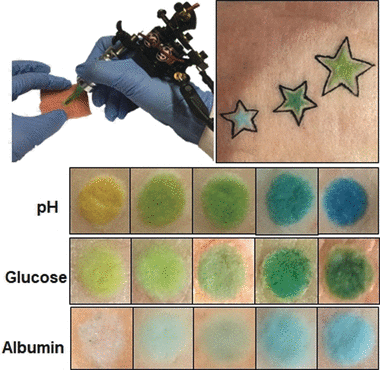
The Art of Sensing within the Skin
The art of tattooing may have found a diagnostic twist. A team of scientists in Germany have developed permanent dermal sensors that can be applied as artistic tattoos. As detailed in the journal Angewandte Chemie, a colorimetric analytic formulation was injected into the skin instead of tattoo ink. The pigmented skin areas varied their color when blood pH or other health indicators changed.
A tattooist places ink directly in the dermis, a roughly one-millimeter-thick layer of tissue that hosts nerves, blood vessels, and hair follicles. The tattoo needle punctures the epidermis, the uppermost layer of skin, and releases the pigments into the dermis below, where the pigments stain the skin permanently.
Using tattoos for diagnostic rather than cosmetic purposes is a new concept. Researcher Ali K. Yetisen, who works at the Technical University of Munich, Germany, and his colleagues thought the technique could be helpful to place sensor formulations at spots in the body where they can record changes in metabolic substances directly, without any spatial distance or time delay, and perhaps for a very long period of time.
The researchers then identified and adapted three colorimetric chemical sensors that produce a color change in response to biomarkers. The first sensor was a rather simple pH indicator consisting of the dyes methyl red, bromothymol blue, and phenolphthalein. If injected into a model skin patch—a piece of pig skin—the resulting tattoo turned from yellow to blue if the pH was adjusted from five to nine.
The other two sensors probed the levels of glucose and albumin. Albumin is a carrier and transport protein in the blood. High glucose levels in the body may indicate diabetic dysfunction, whereas falling albumin levels can indicate liver or kidney failure. The glucose sensor consisted of the enzymatic reactions of glucose oxidase and peroxidase, which, depending on the glucose concentration, led to a structural change of an organic pigment, and a yellow to dark green color change. The albumin sensor was based on a yellow dye that, upon association with the albumin protein, turned green.
The scientists then applied several sensor tattoos onto patches of pig skin. When they changed the pH or the glucose or albumin concentrations, the colors of the decorated areas changed accordingly. They quantified these visible effects by evaluating the colors with a simple smartphone camera and an app.
The authors claim that such sensor tattoos could allow permanent monitoring of patients using a simple, low-cost technique. With the development of suitable colorimetric sensors, the technique could also extend to recording electrolyte and pathogen concentrations or the level of dehydration of a patient. Further studies will explore whether tattoo artwork can be applied in a diagnostic setting.
Learn more: The Art of Sensing within the Skin
The Latest on: Dermal tattoo sensors
[google_news title=”” keyword=”dermal tattoo sensors” num_posts=”10″ blurb_length=”0″ show_thumb=”left”]
via Google News
The Latest on: Dermal tattoo sensors
- A woman said her tattoos got her rejected for a job, but experts say personality is far more importanton April 26, 2024 at 8:38 am
Experts said tattoos could influence hiring decisions, especially in customer-facing roles. But overall, personality and cultural fit are more important, they said. A TikToker, Ash Putnam ...
- Tattoo Artists Reveal the Most Stereotypical 'Millennial' Tattooson April 25, 2024 at 11:56 am
Tattoos are a great way to express your individuality and are even believed to boost confidence and self esteem. However, one of the drawbacks to getting inked is that, much like fashion, tattoo ...
- Bioadhesive for sticking sensors on squishy squidon April 18, 2024 at 5:00 pm
The lives of most sea creatures remain largely mysterious. Bound to boats or land, researchers rely on sensors to collect data and piece together how marine animals move through their environments.
- Aqara’s best presence sensor just got even betteron April 8, 2024 at 5:00 pm
That’s where presence sensors come in, and there are few more impressive than the Aqara FP2. This presence sensor has been an impressive piece of kit ever since it was released, but just ...
- pH sensoron September 30, 2023 at 5:01 pm
[Stephen]’s system uses commercially available sensors that track pH levels and Oxidation-Reduction Potential (ORP), both basic measurements that indicate water quality. A second set of sensors ...
- wind sensoron July 5, 2021 at 5:00 pm
Weather stations are a popular project for experimenting with various environmental sensors, and for wind speed and direction the choice is usually a simple cup anemometer and wind vane.
- How Smart Sensors Are Changing Golfon March 14, 2021 at 6:00 am
I cover golf, luxury technology, and the intersection of the two. Since late 2014, Arccos Golf smart sensors have been collecting data about golfers’ games. These tiny innovations screw into the ...
- The Best O2 Sensors to Keep Your Engine Running Smoothlyon November 16, 2020 at 3:59 pm
Don't let failing oxygen sensors compromise your engine's performance. O2 sensors are critical to emissions control on your car, SUV or truck. As the name implies, the O2 sensor (also called an ...
- The Best O2 Sensors to Keep Your Engine Running Smoothlyon November 16, 2020 at 3:59 pm
Don't let failing oxygen sensors compromise your engine's performance. O2 sensors are critical to emissions control on your car, SUV or truck. As the name implies, the O2 sensor (also called an ...
- Sensors - definitionon August 21, 2020 at 6:41 pm
Both sensors measure rate of change; they just measure the rate of change for different things. In practice, that means that an accelerometer will measure the directional movement of a device but ...
via Bing News










